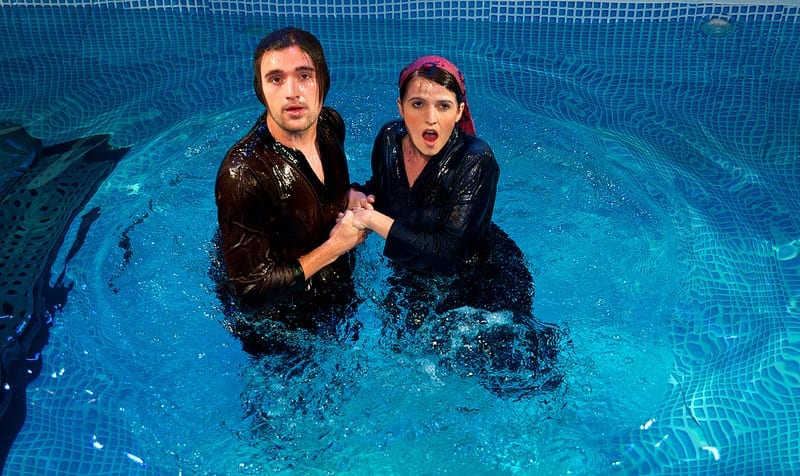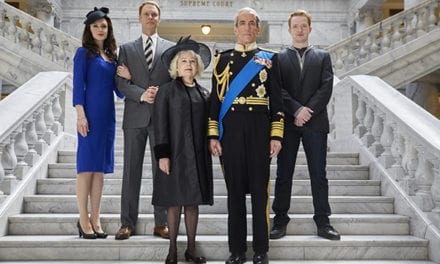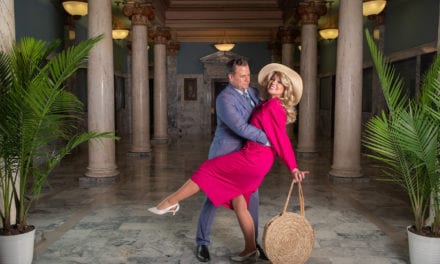SALT LAKE CITY — I’m a sucker for Greek mythology. There’s just so much going on, and among such fascinating characters: gods and mortals, lovers and enemies, queens, and commoners. The Greek canon is full of fascinating stories, often dark, and really very human—the Olympian gods were flawed individuals, with very human personalities despite their immense power and immortality. Mary Zimmerman‘s beautiful play Metamorphoses explores several of these myths—some familiar, others less so—currently being presented in a respectable production by the University of Utah’s Department of Theatre.
Zimmerman connects the stories using several key theatricalities. First, all the stories share a significant theme: they deal with transformation, whether physical or emotional, voluntary or compulsory. Second, one of the coolest and most memorable aspects of the play is that it sets all the stories in or around a pool of water, as water is by its very nature a transformative element. Seeing how these stories flow, literally, in and out of the pool is reason enough to recommend seeing this show. Finally, the stories are told by an ensemble of actors, each playing several different roles. The ensemble is a core concept of Greek theatre, even if Zimmerman—and in this production, director Jamie Rocha Allan—does not employ the ensemble as a chorus. The fact that the actors all play multiple roles also emphasizes the play’s theme of transformation.
Allan’s cast is a true ensemble. There are, as to be expected with an academic production, both particularly strong and weak links in the cast, but overall I commend the group for their solid ensemble dynamic. All seemed to relish the dark beauty of the play as well as the chance to play a variety of characters; they recognize and embrace the opportunity to support each other throughout the evening, which is a pleasure to watch. The ensemble gelled best while telling the story of Baucis and Philemon (Katie Stansfield and Alexander Eltzroth), an adorable elderly couple who unknowingly serve a humble dinner to Zeus and Hermes. I’m fairly sure that everyone in the cast appeared in the staging of this scene, a small and lovely mosaic of the power of human kindness. The vignette was definitely one of my favorites of the evening.
 Allan creates lovely stage pictures, though some of the blocking feels a little stagnant now and then. While the pool is a fabulous device, it does occupy a significant chunk of stage space, and there were moments when I found myself second-guessing Allan and Zimmerman (How are they going to use the pool next?) instead of being pulled organically through the web of stories. There are clever moments of stage magic throughout, and I gladly suspended my disbelief to enjoy them: the tiny clang of cymbals sounding with every golden step of King Midas, a little fall of actual rain, or the personification of familiar concepts like sleep and hunger. Some of the more magical transformations—mortals becoming birds or trees, for example—are truly stunning, especially when emphasized by Jesse Portillo‘s fine lighting design.
Allan creates lovely stage pictures, though some of the blocking feels a little stagnant now and then. While the pool is a fabulous device, it does occupy a significant chunk of stage space, and there were moments when I found myself second-guessing Allan and Zimmerman (How are they going to use the pool next?) instead of being pulled organically through the web of stories. There are clever moments of stage magic throughout, and I gladly suspended my disbelief to enjoy them: the tiny clang of cymbals sounding with every golden step of King Midas, a little fall of actual rain, or the personification of familiar concepts like sleep and hunger. Some of the more magical transformations—mortals becoming birds or trees, for example—are truly stunning, especially when emphasized by Jesse Portillo‘s fine lighting design.
 The overall design of the production is cohesive and complete. Gage Williams‘s set is sparse and functional, providing room for Zimmerman’s text to flower. Shea Madson’s sound design is lovely and does not distract from the play. Brenda Van der Wiel‘s costumes, especially when paired with Elise Russon Harris‘s hair and make-up designs, successfully establish the visual world, layering an original, contemporary twist atop a more traditional Greek base. Many of the costumes are lovely, using color and texture to the advantage of the production; Phoebus Apollo’s (Alexander Eltzroth) suit of sunlight, for example, and Aphrodite’s (Marcella Pereda) gorgeous coral-colored gown both felt representative of Olympus. There were a couple of specific choices that took me out of the action, however. In one instance, the messenger God Hermes (Kaltin Kirby) wore a peculiar headdress of silver wings. While the wings are symbolic of Hermes and his fleetness, this particular pair look awkwardly large and plasticky, drawing attention in a comical way that doesn’t mesh with the rest of Van der Wiel’s sophisticated pieces.
The overall design of the production is cohesive and complete. Gage Williams‘s set is sparse and functional, providing room for Zimmerman’s text to flower. Shea Madson’s sound design is lovely and does not distract from the play. Brenda Van der Wiel‘s costumes, especially when paired with Elise Russon Harris‘s hair and make-up designs, successfully establish the visual world, layering an original, contemporary twist atop a more traditional Greek base. Many of the costumes are lovely, using color and texture to the advantage of the production; Phoebus Apollo’s (Alexander Eltzroth) suit of sunlight, for example, and Aphrodite’s (Marcella Pereda) gorgeous coral-colored gown both felt representative of Olympus. There were a couple of specific choices that took me out of the action, however. In one instance, the messenger God Hermes (Kaltin Kirby) wore a peculiar headdress of silver wings. While the wings are symbolic of Hermes and his fleetness, this particular pair look awkwardly large and plasticky, drawing attention in a comical way that doesn’t mesh with the rest of Van der Wiel’s sophisticated pieces.
The theatre is a place we go in hope of being, to a certain extent, transformed; we’re looking to be carried to another and time and place. The stories told in Metamorphoses may be implausible to us as a contemporary audience, but they all turn on the transformative love human beings can offer one another every day. Zimmerman’s play is beautiful, and this production of it is worth experiencing.







